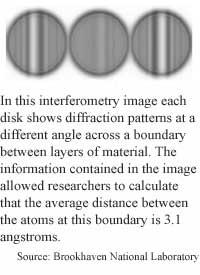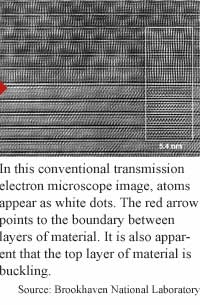
Interference delivers atomic detail
By Kimberly Patch, Technology Research NewsToday's electron microscopes can image individual atoms, and they can determine how close atoms are to each other within an angstrom. This is not a fine enough measure, however, to determine all the subtle changes in atomic structure that, for instance, allow a material to be a superconductor.
Researchers at Brookhaven National Laboratory have developed a technique that uses light interference patterns to determine atom placement within a picometer. There are 100 picometers in an angstrom and one billion picometer's in a millimeter.
The ability to determine atom placement within a picometer is potentially useful for designing many high-tech materials with greater precision. "If you look at the structure of anything, all the physical properties of a material [are] determined by the structure -- by the atomic arrangement," said Yimei Zhu, a tenured scientist and group leader at Brookhaven National Laboratory.
The nucleus of an atom has a radius of about an angstrom, and in solid materials atoms are four or five angstroms apart. The precision of the interferometry technique versus what was possible before is analogous to determining the position of an object the size of a person within a centimeter rather than a meter.
The technique uses a top-of-the-line 300-kilovolt transmission electron microscope. The results are not images of atoms with measurable distances between them, however. Instead, the researchers use indirect measures to determine the average distance of a group of atoms along an interface between two substances.
An ordinary camera uses only the amplitude of lightwaves to render an image. There is additional information about an object's position, however, in the phase, or interference patterns of two coherent light sources bouncing off it. Light beams that are coherent, or tuned to the same wavelength, cancel or amplify each other in a discernible pattern. Holograms use both attributes of light to build images, gaining the illusion of depth from phase information.
The interferometry technique uses both lightwave amplitude and interference to gain more information about the distance between atoms. In the images the technique produces, each disk represents a diffraction of coherent light sources bouncing off a certain plane of a material.
The researchers determine atom placement based on these multiple diffraction patterns. "Each disk tells you... how the crystals are related across a boundary," said Zhu.
The researchers developed the technique as part of an ongoing attempt to "determine atom displacement accurately enough to link the structure to the property... in superconductors. It's very important for practical applications because small lattice displacement significantly changes superconductivity," Zhu said. Atoms in crystals like semiconductors line up in a regular, lattice structure.
Much of the electronics industry depends on properties determined by small lattice changes in semiconductors. Many semiconductor devices are made of layers of material, and at the interfaces between the layers, atoms are displaced. The common practice of doping semiconductors, or impregnating them with another substance, also changes the semiconductor's lattice structure. "The [atoms] will move around a little bit," said Zhu.
Zhu's colleagues in the research were Lijun Wu and J. Tafto of Brookhaven National Laboratory. They published the research in the December 11, 2000 issue of Physical Review Letters. The study was funded by the Department of Energy.
Timeline: Now
Funding: Government
TRN Categories: Semiconductors and Materials
Story Type: News
Related Elements: Technical Paper, "Picometer Accuracy in Measuring Lattice Displacements across Planar Faults by Interferometry in Coherent Electron Diffraction," December 11, Physical Review Letters
Advertisements:
December 6, 2000
Page One
Biomotor powers propeller
Safe havens offer practical quantum processing
Mechanical data storage goes massively parallel
Frosted nanotubes make metal wires
Interference delivers atomic details


News:
Research News Roundup
Research Watch blog
Features:
View from the High Ground Q&A
How It Works
RSS Feeds:
News
Ad links:
Buy an ad link
| Advertisements:
|
 |
Ad links: Clear History
Buy an ad link
|
TRN
Newswire and Headline Feeds for Web sites
|
© Copyright Technology Research News, LLC 2000-2006. All rights reserved.